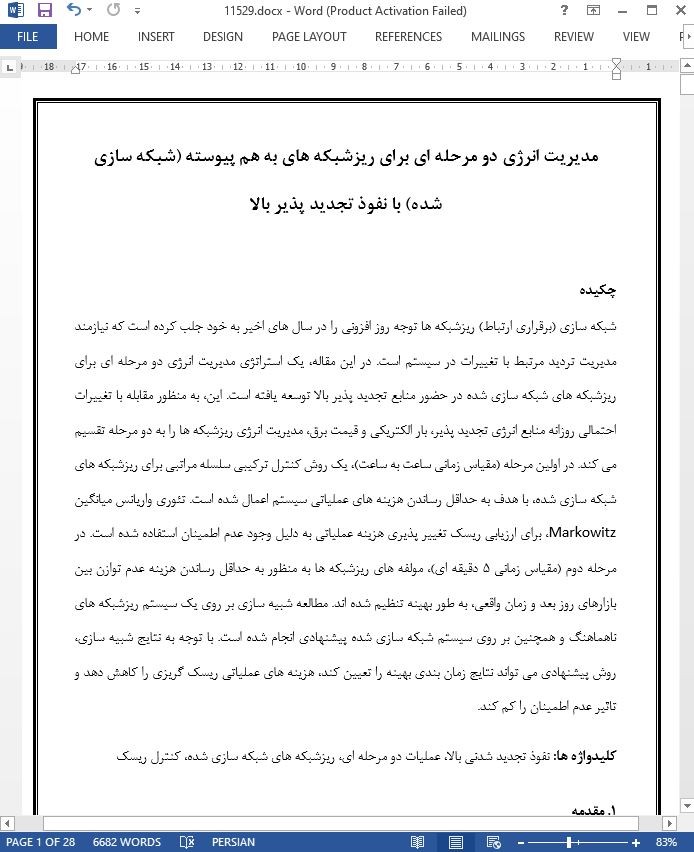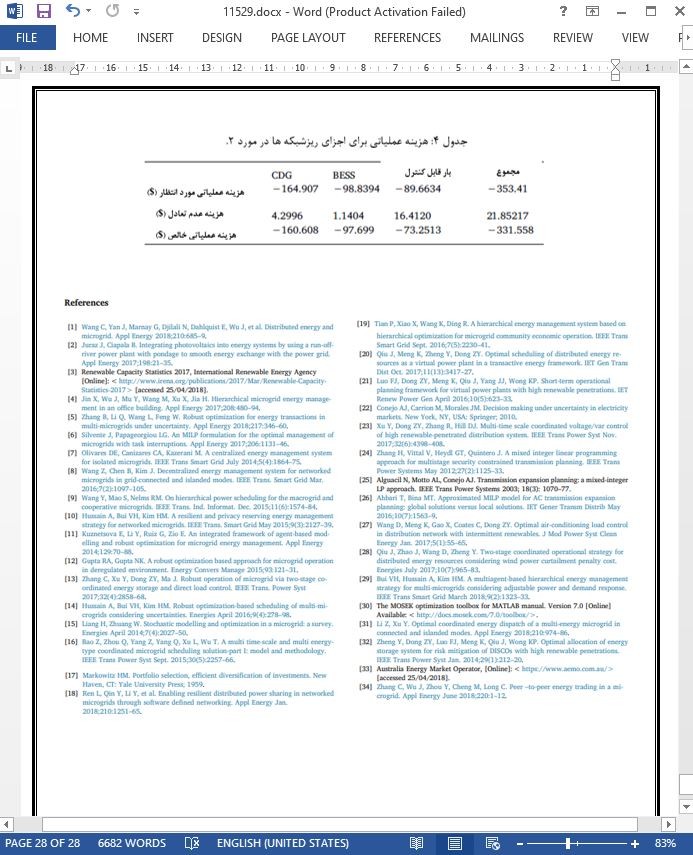
مدیریت انرژی دو مرحله ای برای ریزشبکه های به هم پیوسته با نفوذ تجدید پذیر بالا
چکیده
شبکه سازی (برقراری ارتباط) ریزشبکه ها توجه روز افزونی را در سال های اخیر به خود جلب کرده است که نیازمند مدیریت تردید مرتبط با تغییرات در سیستم است. در این مقاله، یک استراتژی مدیریت انرژی دو مرحله ای برای ریزشبکه های شبکه سازی شده در حضور منابع تجدید پذیر بالا توسعه یافته است. این، به منظور مقابله با تغییرات احتمالی روزانه منابع انرژی تجدید پذیر، بار الکتریکی و قیمت برق، مدیریت انرژی ریزشبکه ها را به دو مرحله تقسیم می کند. در اولین مرحله (مقیاس زمانی ساعت به ساعت)، یک روش کنترل ترکیبی سلسله مراتبی برای ریزشبکه های شبکه سازی شده، با هدف به حداقل رساندن هزینه های عملیاتی سیستم اعمال شده است. تئوری واریانس میانگین Markowitz، برای ارزیابی ریسک تغییر پذیری هزینه عملیاتی به دلیل وجود عدم اطمینان استفاده شده است. در مرحله دوم (مقیاس زمانی 5 دقیقه ای)، مولفه های ریزشبکه ها به منظور به حداقل رساندن هزینه عدم توازن بین بازارهای روز بعد و زمان واقعی، به طور بهینه تنظیم شده اند. مطالعه شبیه سازی بر روی یک سیستم ریزشبکه های ناهماهنگ و همچنین بر روی سیستم شبکه سازی شده پیشنهادی انجام شده است. با توجه به نتایج شبیه سازی، روش پیشنهادی می تواند نتایج زمان بندی بهینه را تعیین کند، هزینه های عملیاتی ریسک گریزی را کاهش دهد و تاثیر عدم اطمینان را کم کند.
1. مقدمه
نگرانی های بسیار زیاد درمورد محدودیت منابع انرژی، تغییرات آب و هوایی و همچنین افزایش قیمت انرژی، کشورها را به سمت افزایش ادغام منابع انرژی تجدیدپذیر (RESها) با سیستم های قدرت مدرن، عمدتا به شکل پانل های فتوولتائیک خورشیدی و توربین های بادی، هدایت کرده است [1]. یک انتقال از سوخت های فسیلی و تجدید ناپذیر به انرژی تجدید پذیر و پایدار در سراسر جهان در حال رخ دادن است [2].
6. نتیجه گیری و چالش تحقیقات آینده
در این مقاله یک استراتژی مدیریت انرژی دو مرحله ای، یعنی یک زمان بندی یک ساعته روز بعد و توزیع زمان واقعی 5 دقیقه ای، برای MG های شبکه سازی شده در حضور نفوذ تجدید پذیر بالا پیشنهاد می دهد. در مرحله زمان بندی روز بعد، یک روش کنترل سیستم مدیریت انرژی ترکیبی با توجه به ساختار سلسله مراتبی ریزشبکه های شبکه سازی شده، اتخاذ شده است. هدف کنترل، به حداقل رساندن هزینه عملیات با یک مبنای روزانه است و تغییرات هزینه عملیاتی از طریق ادغام تئوری میانگین واریانس Markowitz با تابع هدف کنترل شده اند. عدم اطمینان خروجی منابع انرژی تجدیدپذیر، بار الکتریکی و قیمت برق در مرحله اول مورد توجه قرار گرفته اند.
Abstract
Networking of microgrids has received increasing attentions in recent years, which requires the uncertainty management associated with variations in the system. In this paper, a two-stage energy management strategy is developed for networked microgrids under the presence of high renewable resources. It decomposes the microgrids energy management into two stages to counteract the intra-day stochastic variations of renewable energy resources, electricity load and electricity prices. In the first stage (hourly time scale), a hierarchical hybrid control method is employed for networked microgrids, aiming to minimize the system operation cost. The mean–variance Markowitz theory is employed to assess the risk of operation cost variability due to the presence of uncertainties. In the second stage (5-min time scale), the components in microgrids are optimally adjusted to minimize the imbalance cost between day-ahead and real-time markets. Simulation study is conducted on an uncoordinated microgrids system as well as on the proposed networked system. According to the simulation results, the proposed method can identify optimal scheduling results, reduce operation costs of risk-aversion, and mitigate the impact of uncertainties.
1. Introduction
Heightened concerns about energy resource limits, climate change, as well as increasing energy prices, has led countries to increased integration of renewable energy sources (RESs) into modern power systems, primarily in the form of solar photovoltaic panels and wind turbines [1]. A transition from fossil-based and non-renewable fuels to renewable and sustainable energy is occurring around the world [2].
6. Conclusions and future research challenge
This paper proposes a two-stage, i.e. an hourly day-ahead scheduling and 5-min real-time dispatch, energy management strategy for networked MGs in the presence of high renewable penetration. In the day-ahead scheduling stage, a hybrid energy management system control method is adopted considering the hierarchical structure of networked microgrids The control objective is to minimize the operation cost on a daily basis and the operation cost variations are captured by incorporating mean-variance Markowitz theory into the objective function. Uncertainties on renewable energy resources output, electricity load, and electricity price are addressed in the first stage.
چکیده
1. مقدمه
2. تعریف مسئله
2.1. اجزا و شکل MGهای شبکه سازی شده
2.2. استراتژی پیشنهادی
3. مدل سازی اجزا
3.1. CDGها
3.2. BESS
3.3. بار قابل کنترل
3.4. مجموعه های نامشخص از RESها، بار و قیمت برق
3.5. مدل بازار
4. مدل عملیاتی دو مرحله ای پیشنهادی
4.1. مدل زمان بندی بهینه ساعتی روز بعد
4.2. مدل توزیع زمان واقعی 5 دقیقه ای
5. مطالعات موردی
5.1. راه اندازی
5.2. نتایج و بحث
6. نتیجه گیری و چالش تحقیقات آینده
ABSTRACT
1. Introduction
2. Problem description
2.1. Components and configuration of networked MGs
2.2. Proposed strategy
3. Components modeling
3.1. Cdgs
3.2. Besss
3.3. Controllable load
3.4. Uncertain sets of RESs, load, and electricity prices
3.5. Market model
4. Proposed two-stage operation model
4.1. Hourly day-ahead optimal scheduling model
4.2. 5-minute real-time dispatch model
5. Case studies
5.1. Set up
5.2. Results and discussion
6. Conclusions and future research challenge
- ترجمه فارسی مقاله با فرمت ورد (word) با قابلیت ویرایش، بدون آرم سایت ای ترجمه
- ترجمه فارسی مقاله با فرمت pdf، بدون آرم سایت ای ترجمه



